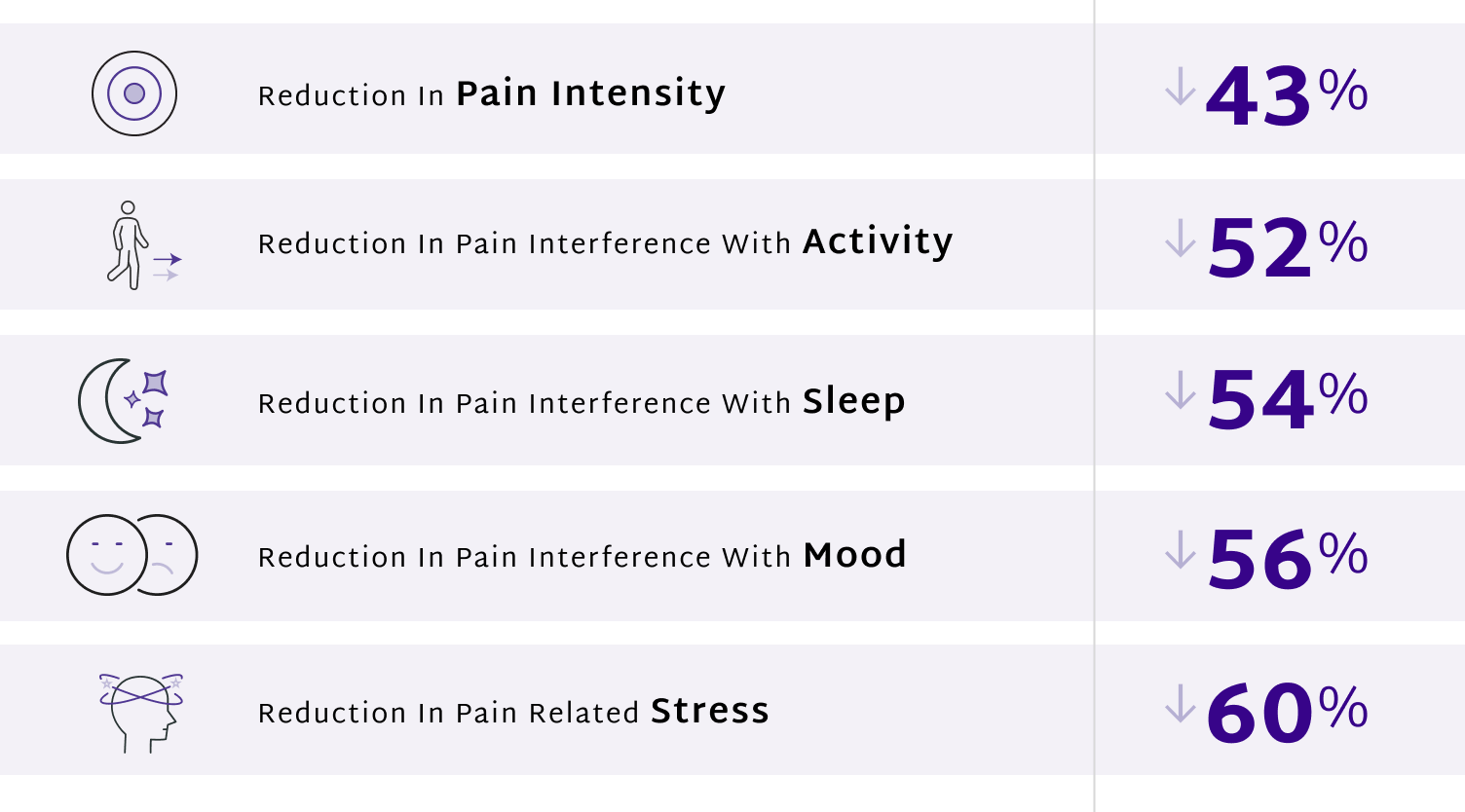Unlock Relief
The RelieVRx® virtual reality therapy for chronic lower back pain is fully covered for those with VA benefits.
Get StartedBootcamp For Your Brain
The self-guided, in-home program can reduce your discomfort while teaching you skills for managing your everyday CLBP.
Used for an average of 6 minutes per session.
Each of the 56 immersive sessions builds upon the lessons from the last one.
To help change how you think, feel, and react to pain.
How the RelieVRx program works
Watch the video below to learn how this VR-enabled medical device and its pre-programmed therapy content can help you develop new skills and habits to manage your chronic lower back pain.
Getting support early can make a big difference
Over time, chronic lower back pain treatments can begin to weaken or stop working all together. Many Veterans experience chronic lower back pain for more than a year before meaningful treatment. This can lead to more stress and make movement harder.2,3,4,5
The RelieVRx program gives you the tools to handle pain early and within your current treatment plan.5,6Clinically Validated Chronic Lower Back Pain Relief
In a 56-session clinical trial, participants reported a significant reduction in pain and the impact it has on their daily lives, and those reductions remained in a 2 year follow up trial1,7

The Power Of VR
The effectiveness of established pain management techniques is enhanced by the immersive nature of virtual reality and the immediate feedback it provides.1



A Two-Phase
Approach to Relief:
Just as military preparation moves from training to deployment, the MyRelieVRx Bundle™ offers a two-phase approach to recovery and relief.
RelieVRx®
An FDA-authorized VR therapy that uses a clinically validated, structured curriculum to build core cognitive behavioral skills for managing chronic lower back pain.
SustainVR™
A wellness device that uses evidence-based techniques to provide on-demand support and skill reinforcement that may help you manage life with chronic pain, all accessible through a device you keep.
Get Started
Let your provider know that you are interested in the RelieVRx program.
Bring the Veteran Packet to your appointment to help guide your conversation.
Easy To Use
The RelieVRx device is shipped directly to your home with easy-to-follow instructions. Once you have completed the program, simply return the device in the original packaging using the provided prepaid return shipping label.
User scores rank the RelieVRx device as easier to use than an ATM.8
If you are currently a RelieVRx patient and need assistance, please don't hesitate to call or email us
Veterans Support Team
AVR Pathway®, our support team includes fellow Veterans who truly understand your journey and are here to help you find relief. The AVR Pathway team is your primary point of contact for technical and non-medical questions.
Email UsMeet the Team
Daniel is a retired U.S. Air Force TSgt with 20 years of service. He is passionate about serving others and enjoys spending time with his family.
Tony is a retired Marine Corps Reserves and Air Force SMSgt with 28 years of service. He now dedicates his life to ministry, service, and family, especially his four grandchildren.
Healthcare Providers
Give Veterans an effective, low-risk way to treat chronic lower back pain at home with RelieVRx Program.
- Vendor: Lovell Government Services
- Brand: RelieVRx
- GSA Contract # SPE2DE22DA020
- FSS Contract # 36F79725D0128
Part Numbers:
- RelieVRx # RVX-2002
- (or)
- MyRelieVRx Bundle # RSV-1001
(Includes: RelieVRx And SustainVR)
Follow the standard submissions process for your Community Care Network DME Consult.
Description language for reference:
RelieVRx, Immersive Therapeutic Virtual Reality device, for chronic low back pain, 56 session treatment including patient services for adherences reminders and/or progress reports.
Contact Lovell Government Services at 850-684-1867 for support with your order or to place an order over the phone.

Contract Vehicles
- FSS/GSA Contract # SPE2DE22DA020
- FSS Contract # 36F79725D0128
- DAPA Contract # SP0200-16-H-0011
Part Numbers:
- RelieVRx # RVX-2002
- MyRelieVRx Bundle # RSV-1001
(Includes: RelieVRx and SustainVR)
Contact Info
- customerservice@lovellgov.com
- Phone: 850-684-1867
- Fax: 850-254-9853
- Order online:GSAadvantage.gov
Indication for Use The RelieVRx program is a prescription-use immersive virtual reality system intended to provide adjunctive treatment based on cognitive behavioral therapy skills and other evidence-based behavioral methods for patients (age 18 and older) with a diagnosis of chronic lower back-pain (defined as moderate to severe pain lasting longer than three months). The device is intended for in-home use for the reduction of pain and pain interference associated with chronic lower back pain.
Contraindications
There are no known contraindications.
References
- Garcia LM, Birckhead BJ, Krishnamurthy P, Sackman J, Mackey IG, Louis RG, Salmasi V, Maddox T, Darnall BD. An 8-Week Self-Administered At-Home Behavioral Skills-Based Virtual Reality Program for Chronic Low Back Pain: Double-Blind, Randomized, Placebo-Controlled Trial Conducted During COVID-19. J Med Internet Res. 2021 Feb 22;23(2):e26292.
- Woolf CJ. Central sensitization: Implications for the diagnosis and treatment of pain. Pain. 2011;152 (3 Suppl):S2-S15.
- Gatchel RJ, Peng YB, Peters ML, Fuchs PN, Turk DC. The psychosocial approach to chronic pain: Scientific advances and future directions. Psychol Bull. 2007;133(4):581–624.
- Verbunt JA, Seelen HA, Vlaeyen JW, van de Heijden GJ, Heuts PH, Pons K, Knottnerus JA. Disuse and deconditioning in chronic low back pain: Concepts and hypotheses on contributing mechanisms. Eur J Pain. 2003;7(1):9-21.
- Belitskaya-Levy I, Clark JD, Shih MC, Bair MJ. Treatment Preferences for Chronic Low Back Pain: Views of Veterans and Their Providers. J Pain Res. 2021 Jan 27;14:161-171. doi: 10.2147/JPR.S290400. PMID: 33536780; PMCID: PMC7850463.
- Centers for Disease Control and Prevention. 2022 CDC Clinical Practice Guideline for Prescribing Opioids for Pain — United States, 2022. MMWR Recomm Rep. 2022;71(3):1-95.
- Maddox T, Sparks C, Oldstone L, Maddox R, Ffrench K, Garcia H, Krishnamurthy P, Okhotin D, Garcia LM, Birckhead BJ, Sackman J, Mackey I, Louis R, Salmasi V, Oyao A, Darnall BD. Durable chronic low back pain reductions up to 24 months after treatment for an accessible, 8-week, in-home behavioral skills-based virtual reality program: a randomized controlled trial. Pain Med. 2023 Oct 3;24(10):1200-1203.
- Maddox T, Oldstone L, Sparks CY, Sackman J, Oyao A, Garcia L, Maddox RU, Ffrench K, Garcia H, Adair T, Irvin A, Maislin D, Keenan B, Bonakdar R, Darnall BD. In-Home Virtual Reality Program for Chronic Lower Back Pain: A Randomized Sham-Controlled Effectiveness Trial in a Clinically Severe and Diverse Sample. Mayo Clin Proc Digit Health. 2023 Oct 24;1(4):563-573. doi: 10.1016/j.mcpdig.2023.09.003. PMID: 40206316; PMCID: PMC11975703.

